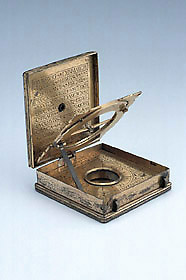
 |
| Catalogue |
 |
 Astronomical Compendium The outer face of the cover has a zodiac-calendar scale and a lunar volvelle, with decorative engraving in each of its corners. The zodiac occupies the outer of the two bands; each sign is named or abbreviated in Latin, divided to 10 and 2, and numbered by 10. The calendar scale also names or abbreviates its months in Latin (though note 'SPTEM'), and each month is divided to 10 and 2, and numbered by 10 (adjusted to the length of the month). Conversions between the zodiac and the calendar are made with the help of the 'INDIX + SOLIS' attached to the volvelle. The index reaches out beyond the radius of the zodiac scale and is only contained within the area of the cover when it points to one of the corners. The volvelle carrying the index has a scale for the age of the moon 1 to 29[1/2], divided to 1/2. It is surmounted by another volvelle with an aperture at its circumference which is set against the scale of the moon's age. When set, a circular aperture in the upper volvelle reveals a diagram for the phases of the moon, with a faintly engraved full moon face. The upper volvelle also has an aspectarium, in which the polygons are marked not with symbols but with the appropriate numbers for trine , quadrature and sextile. The cover bears a strong similarity to the arrangement of nocturnal and lunar volvelle familiar from many later compendia. In particular, the presence of a central hole mirrors a crucial feature of the nocturnal; however, in this case the hole is simply meant to accommodate the projecting holder for the removable gnomon of the instrument's universal equinoctial dial. More obviously, the instrument cannot serve as a nocturnal since it has no scale of hours. A better point of comparison is with a quadrant dated 1438 in the Kunsthistorisches Museum, Vienna. The quadrant is associated with John of Gmunden and carries a similar combination of zodiac-calendar scale and lunar volvelle on its reverse side. The Vienna example does however have an extra index pointer (on the upper volvelle) and an additional lunar scale (0 to 28) inside the calendar scale. The reverse of this instrument's cover has a list of the latitudes of 26 places, mixing individual towns with countries and regions ('LVBECK 56 HIBERNIA 59 SCHOTLANT 59'). Attached at the same hinge as the cover is the hour ring of an equinoctial ring dial. At its hinge is a cross and, around the circle of the hour ring, there is elaborate scrollwork decoration, finely engraved in relief. The scrollwork squares off the ring and carries the inscription 'AVE MARIA 1481'. The hour ring runs 1 to 12, 1 to 12 , though the hours between 10 pm and 2 am are replaced by a zodiac scale. The signs of the zodiac scale are identified by name or abbreviation, and each is divided into 3 parts. The scale is used in conjunction with an inner sliding ring for Italian hours. The sliding ring runs 1 to 24 and, instead of 6, has a dot which serves as the index point for setting the ring against the zodiac scale on the equal hour ring. The sliding ring has a cross piece with a cylindrical holder for the gnomon (missing). The hour ring is elevated by a folding strut (presumably a replacement) which engages with a latitude scale on the plate below. The latitude scale of degrees runs 20 to 60, divided to 5 and 1, and numbered by 5. The equinoctial dial gives valid indications of equal hour time in its latitude range. However, the zodiac scale provided for the direct reading of Italian hours is strictly valid only at the latitude for which it was constructed. It will become increasingly inaccurate as the latitude departs from the 'home' value. The presence of the Italian hour addition might be thought to compromise the universality of the equinoctial dial design. As well as the latitude scale, the plate on which the hour ring is supported carries a further list of 26 latitudes and a compass. The compass bowl is 24 mm in diameter with an offset arrow for magnetic variation; the needle is missing. Around the compass bowl 16 directions are indicated, with the cardinal points are represented by 'S', '[RO]', 'M' and '[CO]'. The base of the instrument carries an unfinished quadrant with straight hour lines, whose sights are on the side of the box opposite the hinge. The base of the box is not permanently attached and can be removed to reveal a wooden block cut around the compass bowl and supporting the plate of the box. Stephen Johnston |



